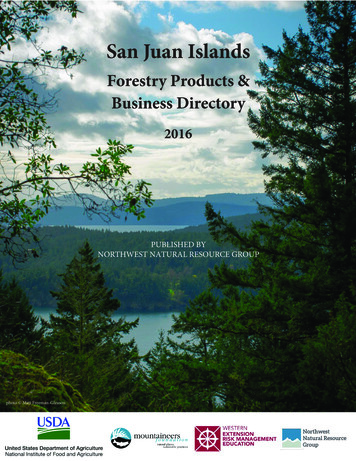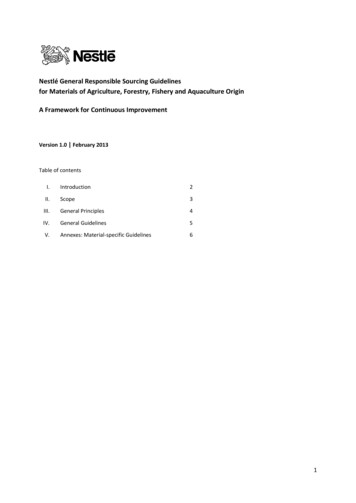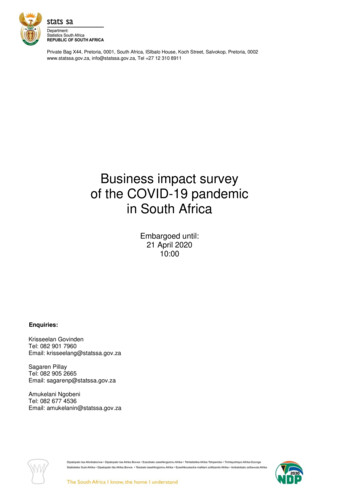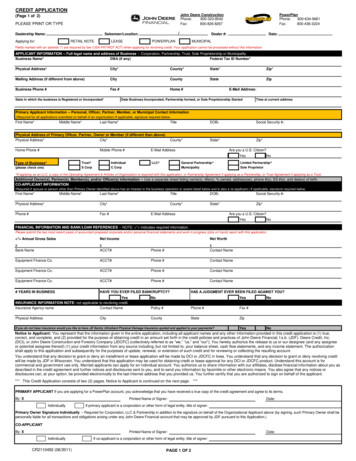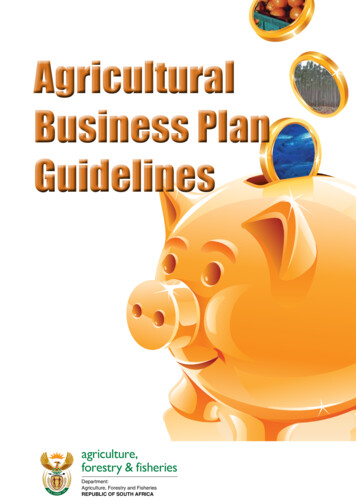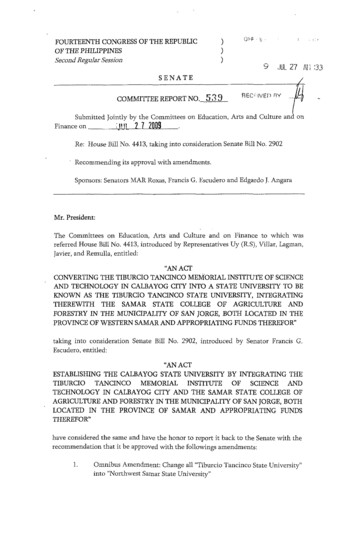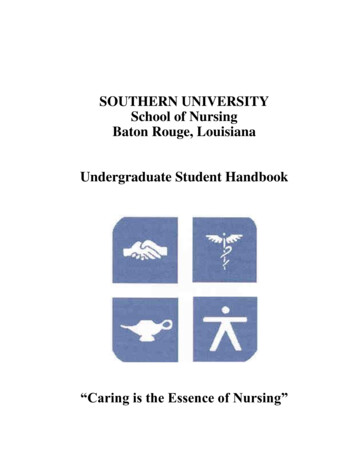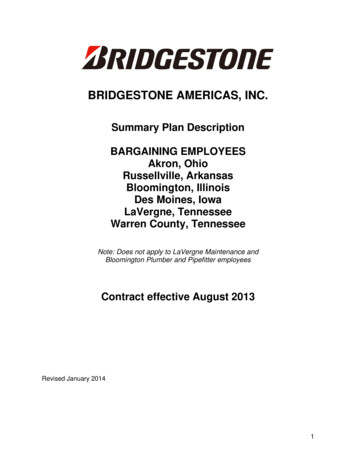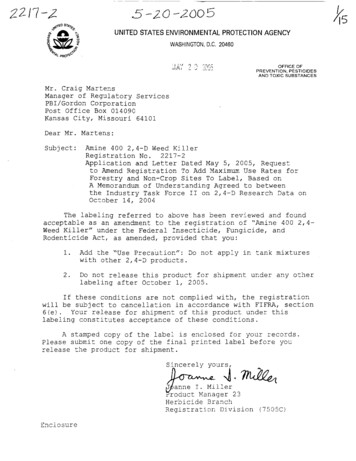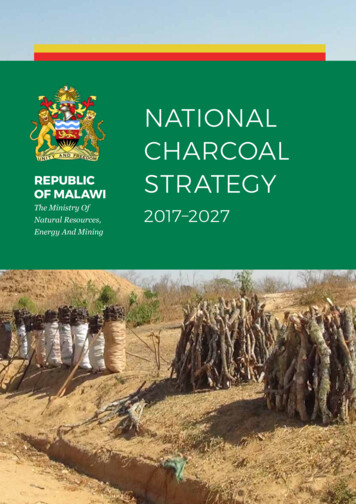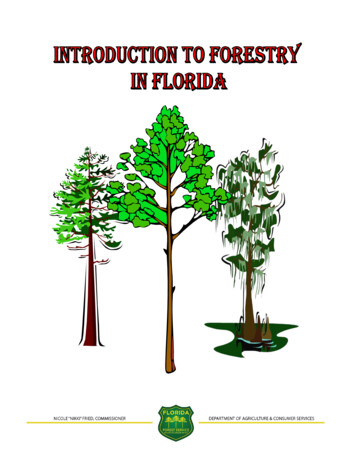
Transcription
ii
Introduction to Forestry in FloridaFlorida Forest ServiceJames R. Karels, State Foresterwww.FDACS.gov/FLForestServiceiii
iv
The forest needs of Florida’s citizens are much greater than many realize, oftenimpacting our lives in ways that we may not always see. It is estimated that theaverage person utilizes 40 products a day that are derived from the forest. This notonly includes the obvious products such as lumber and paper, but items such astoothpaste, ice cream, film, cellophane, tape, adhesives, and enhancements for many ofthe foods we eat and drink. There are well over 5,000 different products that comefrom forests. Of course, there are many other benefits we derive from forests, such asclean air, clean water, recreation and an enhanced environment.Currently the forest industry is theleading agricultural industry in Florida andsecond only to tourism in total impact on thestate’s economy. The timber industry alsoprovides numerous jobs and outdoorrecreation opportunities for millions ofvisitors each year.Forestry is about balancing theecological, social and economic needs of ourstate. Educating our citizens about properforest management practices will helpensure that forests will be healthy and thatthe forest industry remains a viablecommodity for future generations.Jim KarelsState Forester, Florida Forest Servicev
Table of ContentsPart One: Introduction.Introduction .History of Florida’s Forests .Forest Communities .Succession.The Tree.Dendrology .Part Two: Forest Management.Introduction .Planting a Forest.Forest Soils .Managing a Forest.Thinning.Harvesting.Best Management PracticesPrescribed Fire.Wildlife ManagementRecreation.Forest Health .Sustainable Forestry .The Future? .Questions for Part Two.Part Three: Forest Measurements.Introduction .Using an Azimuth Compass .Measuring Trees.Measuring Stands.Measuring Area.Glossary.Bibliography 1525765
This document is also available on the world wide web e-Farmers-of-America-Forestry-ContestsRevised 2012Throughout this manual are words that are bolded and set in italics. The definitions ofthese words can be found in the glossary.ii
Part One: Introduction1
2
IntroductionFlorida’s forests cover a large area of the Sunshine State. Almostone half of the state’s 35.7 million acres is forested. This is morethan the total amount of area that makes up New Hampshire,Vermont, and Massachusetts combined! Florida’s forests support anindustry that creates more than 5,000 everyday items, has a 16.6billion impact on the State’s economy, and supports more than133,000 jobs. The state also gains from the ecological services thatforests perform. Forests purify our water and air, create wildlife habitat, give us naturalbeauty, and provide recreation opportunities. In fact, a year 2000 study showed that fourmillion people visit Florida’s forests each year primarily for observing wildlife. Anadditional 234,000 people visited forests to hunt. They contribute around six billion dollarsto the economy every year, and support almost 65,000 jobs doing so. The added worth ofwater and air purification, biking, hiking, camping, horseback riding, fishing and other forestservices to Florida’s economy are huge!Almost 1/3of the world’stotal land area iscovered byforests!Trees around residences, incity parks, along city streets,and in rural areas clean theair of pollutants. Trees alsoact as sound barriers alongnoisy roads, reduce heatingand cooling costs ofbuildings, and provide uswith aesthetic beauty.The Florida Forest Service had over 1,058,000 acres on 35 StateForests in 2011 that are used for multiple purposes, such as: timber,wildlife protection, recreation, and ecological functions. Thelocations of these 35 State Forests are numbered on the map above.Forestry is the science, art,and practice of managing andusing trees, forests, and theirassociated resources forhuman benefit. The benefitsof trees to the people ofFlorida are more than wemight ever know. Throughthe study and practice offorestry, we can betterunderstand the usefulness offorests to people and toEarth’s ecology.Our demand for lumber or paper production results in a need for forests that is obvious to us.Other reasons that we need forests are not as obvious to many people, such as the need for3
wildlife preservation or natural beauty. Many forest landowners use forest managementpractices that fulfill each of these needs to get what we need.The following sections of this book should teach you aboutFlorida’s forestry history, common trees of Florida, what forestsprovide for us, how to manage these forests sustainably, and howto use forest measurement skills.Questions:1. What does the text mean when it says that forestry bringsmoney into the state’s economy? Discuss some of the waysthat forests bring money into the state’s economy.A well positionedtree can keep ahouse 20% coolerin the summer!Three trees can cutair-conditioningcosts in half!2. What is forestry?3. What are some things that forests do for society?History of Florida’s ForestsOriginally, forests covered about 28 million acres of Florida’s 35.7 million acres of land.The forests stayed intact during 300 years of struggle by England, Spain, and France for thecontrol of Florida. The longleaf pine grew in most of this forest, with Florida being part of90 million acres of the longleaf pine ecosystem that spread almost unbroken from Virginia toeast Texas. Frequent fires, started by both lightning and Native Americans, allowed the fireadapted longleaf pine ecosystem to do well. The fires also gave the land an open, park-likeappearance with low plants and grasses thatwere easy to traverse.During the American Revolutionary War in the1770s, Florida’s forests supplied lumber andpine pitch to England. In the 1830s, cutting ofFlorida’s timber increased near rivers thatserved to float logs to sawmills.Before the 1800s,a traveler could gothrough continuouslongleaf pineforests fromSouth Carolina toFloridaFloating pine logs down the Oklawaha River to thesawmills in 1901. Forests along rivers were someof the first to be cleared because of the ease inwhich the logs can be delivered to the mills. (Photocourtesy of the Florida State Archives)4
After the Civil War, (the 1870s) timber cutting began in Florida on a more massive scale.Several reasons brought this about. First, the nation’s population was growing and movingwestward, creating a need for lumber to build new cities. Then, large steam-powered loggingequipment came about that made it easy to harvest the virgin timber. Third, railroads cameinto all parts of Florida that created a fast, easy way to transport the heavy wood. Finally, thenaval stores industry increased in the early 1900s to tap Florida’s slash and longleaf pines.Naval stores was the common name for pine pitch that was used for sealing wooden shiphull-seams, waterproofing cloth and rope, making glues and varnishes, and for sealing theinsides of clay pots. Cutting marks known as “cat-faces” into living longleaf and slash pinesremoved the pitch. The naval stores industry was Florida’s biggest industry in the early1900s, and Florida was the world’s leader innaval stores production.After 1930,In the 1300s, France’slumberforestswere so reduced,productionand wood was so scarcedwindledthatwooden coffins wererapidly asoftenonly rented forthe bigthe funerals andcompaniesthen reused.ran out ofreadilyavailable virgin timber. Most of thempracticed “cut out and get out” timberingpractices that did not provide for a lasting, orsustainable supply of timber in Florida.These lumbermen saw the vast acreage offorests and assumed that there were plenty oftrees to last their lifetime. The 19.2 millionA young slash pine plantation in North Florida. Slashpine becomes pulpwood size quicker than longleaf pinedo. As a result, slash pines are widely planted wherelongleaf once grew. This can lead to problems if thesite is not suitable for slash pine.acres of pine forests that Florida had in1870 became only 7.5 million acres by1937. Lumber mills closed down, townswere deserted, and the land became barrenand non-productive.The state of Florida decided to create theFlorida Board of Forestry in 1927 toreestablish the forests across the state.They organized the Florida Forest Service“to gather information on forests, theircare and management, to prevent andextinguish forest fires, and to enforce alllaws pertaining to forests and woodlands.”In 1969, legislation moved the agency intothe Department of Agriculture andConsumer Services, changing the name toThis photo by the US Forest Service shows the catfaced trees of a turpentine orchard. Turpentineorchards provided the naval stores industry with pitchthat was used for water-proofing sealants, glues, andvarnishes.5
the Division of Forestry. Then in 2011, the name was changed back to the Florida ForestService in recognition of the agency’s role in the economy and protecting the naturalresources of the state of Florida.Austin Cary was known as the “Father of Southern Forestry” for his preaching ofsustainable forestry practices. He died on the University of Florida campus in 1936.The Florida Forest Service created programs that helped landowners replant trees on theirland. It soon became popular to make paper from the pulp of southern pines. This changedthe look of Florida’s forests. The turpentiners that had developed a distinct heritage inFlorida disappeared as cellulose from pulpwood replaced pitch demands. This changecaused quick-growing slash and loblolly pine to replace much of the remaining longleafforests.The longleaf pine acreage continued to decline to less than onemillion acres by 1989. Despite the loss of longleaf forests, Floridareplants 135 million new seedlings each year. Since the beginningof the Florida Forest Service, industry and private landowners haveplanted more than six billion trees. Florida is on its way to moresustainable management of its forest resources. The era of “cut outand get out” is gone.There is 30%more timbervolume peracre in theU.S. todaythan in 1952.Questions:1. What were Florida’s early forests like before the 1800s? What was the dominant pinespecies?2. What was Florida’s biggest industry in the late 1800s and early 1900s? What happened tothat industry and why did it happen?3. What new technologies from post civil war times to the mid 1900s changed forestry inFlorida on a major scale? Think about and write down what Florida gained and whatFlorida lost with the development of these new technologies.4. Who was Austin Cary? Research this important figure in Florida’s forestry history andwrite down his beliefs and accomplishes. Teachers, have your students research otherfounders of modern forestry in the United States as well.5. Do you think the number of forested acres is growing or shrinking in Florida? Supportyour answer with research from sources other than this book.6
Forest CommunitiesFor a state withsuch littletopography,Florida has manydifferent types offorestcommunities. Infact, a change ofelevation of onlya few feet inFlorida couldmean thedifferencebetween one typeof forestcommunity andanother. Thismap shows someof the main typesof forestcommunities inFlorida.The communitiesshown on the mapon this page onlylists general forest communities. These communities contain thousands more microcommunities. The soil type in each of these communities is a main factor that determineswhich species can grow there. It is very important to know the soil type of the area beforedeveloping a forest management plan.The hardwood forests consist of oaks, hickories, sweetgums, dogwoods, and more. Thesemight be hardwood swamp communities with titi, tupelo, bays, maples, ash, hollies and othermoisture- loving trees. Often times, these communities mix with pine forests. A loblollypine forest could mix with swamp hardwood species, just as longleaf pines could mix withturkey or live oaks. The pineland community generally includes the flatwood slash andlongleaf pine forests, while the sandhills include the pine and oak scrub communities.Cypress communities are usually wet swampy areas or areas along rivers or creeks. Baldcypress communities grow along moving waterways, while pond cypress communities growin pockets of low topography, and usually form a group of trees in a shape known as a dome.7
SuccessionAll plants and animals live inan environment to which theyare specifically adapted. Asenvironmental conditionschange, so do the species ofplants and animals.Succession is the process bywhich plant communitieschange over time. Duringsuccession, plant communitieschange according to factorsthat affect the plants livingthere. For instance, what will happen if a pine forest that is used to fires throughout thecommunity every several years eventually stops having these fires? The oak community(that does not tolerate fires) will probably take over. Succession begins with the first speciesto occupy a bare site (the pioneer species.) Over time, these species replace species thatgrow better at that site at that particular time. Shade, fires, soil moisture, predators, and evenhuman influences determine which plant community will occupy a site at a particular time.If a certain community maintains their control on a site because of their reliance on anoutside factor (such as fire, or humans) then it is a sub-climax community. A communitythat is stable without outside factors (such as an oak forest) is a climax community.The TreeAny discussion of forestry would beincomplete without a look at the majorcomponent of the forest, the tree itself. Atree has roots that take in water andnutrients. It has a xylem that carries thesenecessities up the tree to the leaves. Theleaves make food for the rest of the tree,which travels down to the roots by thephloem. Here is a closer look at each one ofthese main parts of a tree, plus a few more:The roots have tiny root hairs that absorbwater, nutrients, and oxygen that the treemust have to carry on its life processes.Many plants, including pine trees, relyheavily on tiny fungi in the soil calledmychorrizae that assist in water and soilabsorption. Roots also help to anchor thetree against wind and water. The taproot isthe main support root for trees and can8
penetrate deep into the soil. The feeder roots are also known as the surface or lateral rootsbecause they grow laterally just below the soil surface and generally absorb most of thenutrients and moisture.The xylem is the woody portion of the tree and consists of two types of wood, the sapwoodand the heartwood. The sapwood is the living outer portion that takes water and nutrients upfrom the roots to the leaves. The heartwood is the old, dead sapwood that serves as supportfor the tree and as a waste repository.The xylem has a series of annual rings. Eachgrowing season, the tree adds one annual ring.Each ring consists of a light and dark band ofwood. The earlywood is the lighter colored, lessdense wood. The latewood is the darker, denserwood. The vascular cambium cells divide in thexylem to create diameter growth.On a hot summer day, a large tree can transpire 900 gallons of water.This can provide the cooling effect of six room-sized air conditioners!The leaves are the tree’s food-making factories. Leaves use a process known asphotosynthesis to convert water, minerals, carbon dioxide, and the energy from the sun intosugars and oxygen. The tree uses sugar for food, while the oxygen is a waste product. Thegreen substance in the leaves, chlorophyll, makes photosynthesis possible. Openings in theleaf known as stomata release most of the water that the leaf takes up. This cools the surfaceof the leaf and the air around it. This process is evapotranspiration.The phloem is a narrow band of spongy tissue just insidethe bark that takes food from the leaves to the rest of theOne mature tree absorbstree. The vascular cambium cells are also responsible forabout13 pounds of carbonthe addition of new phloem tissue. The cambium layerdioxideper year. One acrecreates xylem cells on the inside of the cambium andof trees supplies enoughphloem on the outside. If a tree’s phloem is severedoxygen each day foraround the tree, the tree will die because the roots would18 people to breathe!not get enough food. This is known as girdling.Foresters sometimes girdle undesirable trees to open upthe canopy for emerging pine seedlings or grasses that are beneficial to wildlife.The cork cambium is responsible for producing the dead cells that make up the bark of thetree. Bark prevents the tree from drying out, and helps protect it from insects and diseases,freezing, and damage by fire. The thick insulating bark of the longleaf pine is one of thereasons for the tree’s tolerance to fire.9
Questions:1. A relationship between two living things where both are benefitted is called mutualism.What is the name of the fungus that is involved in mutualism with trees by helping theirroots absorb water and nutrients? What other organisms have mutualistic behaviors?2. When do you think a tree might have a long tap root, and when might it have little or notap root? Explain your answer.3. Give some reasons how the absence or presence of trees might affect the earth’s climate.4. What part of the tree do you think we make lumber out of?The oldest living tree is the bristlecone pine in the southwestern US. It is about4,600 years old, and started its life when the Egyptians were building the pyramids!DendrologyDendrology is the science of tree identification.This section will look at tree characteristics thatare useful in identifying tree species. Scientistsuse an established system of Latin names todescribe every species. These names avoidconfusion between common names. Forinstance, Quercus laevis is known to people asboth the turkey oak and the blackjack oak. Theword Quercus refers to its genus, the word laevisrefers to its species.Broadleaf trees generally have wide leaves thatshed each fall (deciduous), and have dense, hardwood. The easiest characteristics to observewhen identifying these trees are the shape,arrangement, and margin patterns of their leaves.A leaf has a simple shape if it has one leaflet perbud. A leaf has a compound shape if it has morethan one leaflet per bud.There are always exceptions to the rules. Manybroadleaf trees do not lose their leaves in the fallsuch as the southern magnolia and the live oak.Some broadleaf trees such as the cottonwood andwillow have very soft wood.10
Conifer trees have persistent (evergreen)needle-like or scale-like leaves, usually bearcones, and have relatively soft wood. Theconifers do notconform to thegeneral rulesThe tallest redwoodeither. Themeasured was 367baldcypress losesfeet tall. That is 62its leaves in thefeet taller than thewinter, the redStatue of Liberty!cedar bears afleshy fruitinstead of cones, and longleaf pines have woodthat is denser and harder than the wood ofsome broadleaf trees.Leaves are alternately arranged on a branch,opposite from each other, or in a whorledpattern. These distinguishing characteristicsare easy to see on some of the young branches.The margins of a leaf describe its edge.There are many different margin patterns onleaves in Florida. Leaf arrangement refers tothe way leaves on the same branch areassociated to one another.Conifer trees have persistent (evergreen) needle-likeor scale-like leaves, usually bear cones, and haverelatively soft wood.Questions:1. What is dendrology, and why do you thinkit is important to know dendrology whenyou are studying forestry?2. How can recognizing the shape,arrangement, and margin of the leaves helpyou in identifying the plant?3. Go outdoors and find an example of asimple leaf, a compound leaf, and a needle.Also find examples of alternate leaves andopposite leaves. Look at the differencesbetween these and especially the placementof the bud.11The margins of a leaf describe its edge. Thereare many different margin patterns on leaves inFlorida; look at some of these above.
Some common pine species in Florida’s forests:Pinus elliotti var. elliottiiPinus palustrisLongleaf pines are found throughout the state, exceptfor the southern tip of the peninsula, along pondmargins, in pine flatwoods, and on sandhill sites.The needles are 6-17 inches long, in clusters of three,and gathered towards the ends of the thick, scaly twigs.The cones are six to ten inches long, sometimes slightlycurved, with small curved prickles.The wood is heavy, hard, strong, tough, and durable. Itis used in a variety of building materials along withpulpwood.Slash pine originated along pond margins, but secondgrowth north Florida slash pine now forms a large partof the pine forests of Florida. A variety of slash pine(Pinus elliotti var. densa), known by the common nameof south Florida slash, is found along the lower east andwest coasts and on adjacent islands.The needles, which occur in clusters of two or three,are from 4 to 11 inches long. The cones are mostlythree to six inches long, may be glossy or varnished,and are armed with fine prickles.The wood is heavy, hard, strong, tough, durable, andvery resinous. It is used in building materials and forpulpwood.Pinus clausa var. clausa andPinus clausa var. immuginataPinus taedaLoblolly pine grows on moist, clay soils in northernFlorida.The needles are 3 to 9 inches long in groups of three.The cone is 3 to 5 inches long, are very prickly, andsometimes grow in persistent groups of 2-3 on abranch.The wood is less durable than longleaf and slash pine,and is mostly used for pulpwood and interior buildingmaterial.The Ocala sand pine and the Choctowhatchee sand pineare naturally found on very sandy soils around Ocalanational Forest and the western peninsula respectively.The needles come in groups of two, and are 2-3 incheslong. The cones are 2-3 inches long, and persist on thetree for a long time.The wood is light, brittle, and not very strong. It isprincipally used for firewood, pulpwood, and knottypine paneling.12
Here are examples of some other common Florida trees:Quercus falcataTaxodium distichum var. distichumQuercus virginiana var. virginianaQuercus stellataNyssa sylvatica var. bifloraCarya glabraAcer RubrumLiquidambar styraciflua13
14
Part Two: Forest Management15
16
IntroductionHow important are forests to you? Name a couple things that you get from the forest. It iseasy to think of items such as wood, furniture, or paper, but did you consider any of the 5,000other products that have ingredients in them made from trees? These include some kinds ofice cream, paints, cosmetics, toothpaste, rayon fabric,photographic film, hot dog casings, and many other things.Each year, everyperson in FloridaTrees also provide oxygen, clean water, food and cover foruses enough woodanimals. Animals exhale carbon dioxide. When we burn fossiland paper to makefuels such as coal and oil, it produces carbon dioxide. Plantsup a tree 100 feetturn carbon dioxide into oxygen. Trees and plants also movetall and 16 inchesour water through the water cycle by transpiration and preventin diameter!soil erosion by holding soil particles together with their roots.To make sure that we have trees in Florida for all of these uses, foresters use silviculture.Silviculture is the art, science, and practice of establishing, tending, and reproducing foreststands of desired characteristics. It is based onknowledge of species characteristics andenvironmental requirements. Besides planting trees,An acre of trees canforesters also use practices such as fertilization,remove 13 tons ofthinning, burning, controlling pests, harvesting,dust and gasses fromregeneration, and other activities that maintain athe surroundingforest in a productive and healthy condition.environment every year!Sustainability is a very important concept to thinkabout when studying forestry. Sustainability is the ability for something to last forever. Howis forestry sustainable? Long before logging crews cut the trees, the foresters already haveplans to replant the area with new seedlings. Thus, the wood products taken when weremove the trees will be available when the new seedlings mature. Sustainable silviculturaloperations make sure that wood and wood fiber is around as long as we keep replanting treesand managing them properly. If a forester’s goal is to keep the supply of large timbersustainable, the forester must manage the forest so that the amount of large timber that isharvested does not exceed the amountthat can be grown to replace it. If theforester is trying to keep the supplyof smaller timber or pulpwood forpaper sustainable, then the forestershould manage the forest for smalltrees in much the same way.It is important to manage resources in a way that does notharm the living and non-living things that make up theecosystem, while providing for the aesthetic beauty,recreational opportunities, and profit that people desire.17Sustainability is about much morethan the wood products, though. Theparts of the ecosystem that surroundforestry practices (such as air andwater quality, soil quality, wildlife
value, and recreation and aesthetic value) should be sustainable as well. Scientists andforesters understand that the forest is a part of a great cycle. Thenutrients, the water, the air, and the living things all make up theforest and allow it to prosper. With any one of these componentsConcrete floorsdamaged, the forest has little hope of being completely sustainable.need 21 timesJust looking into the near future is no longer enough; forestmore energymanagers must consider how the practices done today will affectto produce thanthe earth many generations later. If we want to ensure that forestrydo wood floors.is a completely sustainable practice, we must consider all of thecomponents of the ecosystem.The challenge for foresters of the past generation was to replace the “cut out and get out”habits with more sustainable reforestation practices. The challenge for foresters today is tocreate and popularize a forest management method that is completely sustainableecologically, socially, and economically.Your challenge for the remainder of this book is to think about how the forestry practices youread about are or are not sustainable. How does it compare with the sustainability of othernatural resources, such as oil, or metal? How can certain forestry practices be moresustainable than they are now? As you read this book, think about how you would go aboutmanaging a forest that sustainably supplies economic, ecological, and social benefits.Questions:1. List ten wood and ten non-wood products that come from trees.2. Define silviculture in your own words.Each person inFlorida uses675 pounds ofpaper per year.3. What does sustainable mean? How has forestry become more sustainable in the past 100years in Florida? How can forestry continue to become more sustainable in the next 100years?18
Planting a ForestForest management is a great stewardship of your land. There is a definite pride andpleasure in seeing your forestland providing for aesthetics, wildlife, conservation ofecosystems and natural resources, and recreation while at the same time supplyingsociety with the forest products they demand. Many landowners consider the financialprofit from timber management an important objective, and many landowners care deeplyabout taking good care of their land.Planting pines and direct seeding are forms of artificialregeneration. Florida’s primary species for wood products arepines. Northern states tend to use more hardwoods thanFlorida does. The main species planted in Florida include theslash pine, loblolly pine, longleaf pine, and sand pine. Each ofthese species prefer full sun, and require a certain amount ofsite preparation to assure as little competition from fastergrowing grasses, shrubs, and trees as possible.Ten new treesare planted byforest landownersfor each Floridianevery year.Knowing which species to plant is very important.Slash pine grows naturally on fertile pond margins;longleaf pines grow naturally on sandy sites; loblollygrows well on upland soils with clay; and sand pinesgrow on scrublands. Planting the species that isappropriate for the site will reduce the possibility ofproblems with insects, disease, or poor growth. Seethe section on forest soils below for more information.If the site supports turkey oak (“blackjack” oak) andnot laurel oak, then this is a very dry site. Longleafpine was historically the native species on most pinesites except for the wet areas next to and in cypressponds (where slash pine originated), and with thehardwoods in the creek bottoms (where loblollyoriginated). Longleaf has better insect and diseaseresistance, better fire resistance, and is a much bettertree for wildlife. It also makes great pine straw andvaluable big timber.The Longleaf pine starts its life in a grassstage.Longleaf as a seedling has no stem and stays close tothe ground like a clump of grass (called a grass stage).which makes it more resistant to fire.in order to be resistant to fire. During this time theseedling is building an extensive root system. Onceheight growth is initiated, after two to five years, growth is very rapid.Scalping is a common site preparation practice for planting cropland and pastureland.Scalping peels back the sod to a depth of about 4 inches and for a width of about 2.5 feet.19
This creates a mineral soil strip, reducing competition from weeds. Scalping improvesinitial growth and survival of the seedlings, and it reduces the likelihood of infection bycertain soil insects and diseases. One insect
Forestry is the science, art, and practice of managing and using trees, forests, and their associated resources for human benefit. The benefits of trees to the people of Florida are more than we might ever know. Through the study and practice of forestry, we can better understand th
